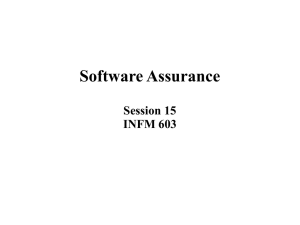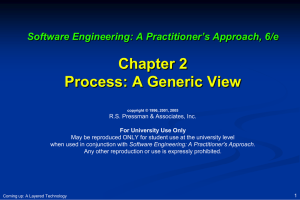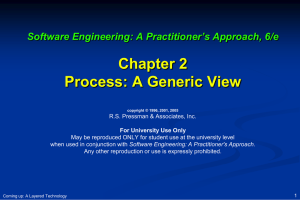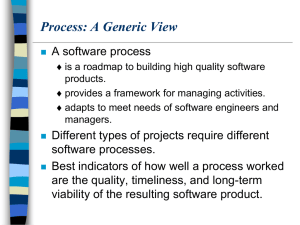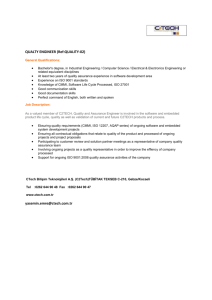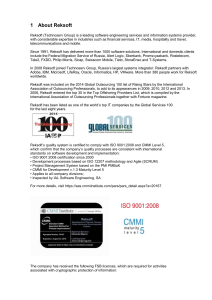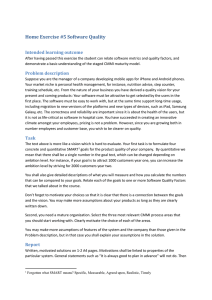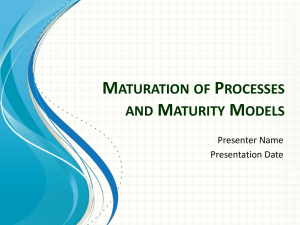1.264 Lecture 5 System Process: CMMI, ISO
advertisement
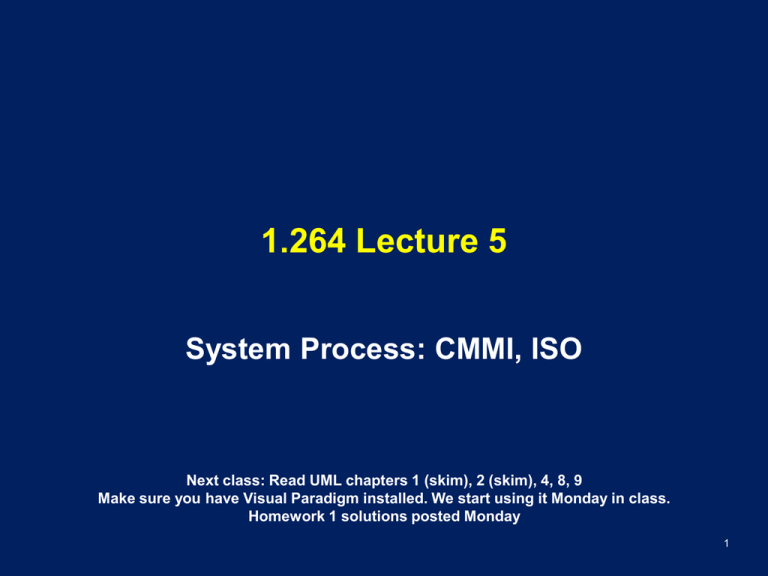
1.264 Lecture 5 System Process: CMMI, ISO Next class: Read UML chapters 1 (skim), 2 (skim), 4, 8, 9 Make sure you have Visual Paradigm installed. We start using it Monday in class. Homework 1 solutions posted Monday 1 Discussion: Case studies • Chemical inventory case study – List the errors made – Outline resource estimation steps that should have been used – Outline process steps that should have been followed • RFID case study – What lifecycle model would you use? – How would you give a time estimate? – List major project risks and how to mitigate them 2 Capability Maturity Model Integration • Developed at Software Engineering Institute (SEI), Carnegie-Mellon University (www.sei.cmu.edu) • Method for process assessment and improvement • Five level model of maturity and capability – – – – – 1: Initial/Performed 2: Managed 3: Defined 4: Quantitatively Managed 5: Optimizing • Predictability, effectiveness and control of software processes improve as organization moves up these levels • One old reading on CMM/CMMI is on course Web site • Current material is at http://www.sei.cmu.edu/cmmi/ 3 CMMI Motivation • CMMI covers three interlocking areas: – Development – Services – Acquisition • CMMI Development: – 20 years of unfulfilled promises about productivity and quality gains from new software technology • Databases, object oriented programming, Internet, … – Organizations realized fundamental problem is the inability to manage the software process – CMMI provides guidance on how to evolve toward a culture of software engineering and rational management 4 CMMI Maturity Level 1: Initial • Ad hoc, occasionally chaotic • Few processes defined • Success depends on individual effort and heroics – This is what you’re taught to do in school… 5 CMMI Maturity Level 2: Managed • Basic project management processes established to track cost, schedule, functionality • Discipline in place to repeat earlier successes on projects with similar applications • Key processes focus on basic project management controls – Requirements management: initial spec, change control – Software project planning: resource estimation based on past performance – Software project tracking and oversight – Software subcontract management – Software quality assurance: code reviews, test plans, tracking – Software configuration management • At level 2, you can measure what’s going on, and that helps understand future projects – A project or group can assess at level 2 6 CMMI Maturity Level 3: Defined • Software process for management and development is documented, standardized and integrated into an overall process for the organization • All projects use approved, tailored version of standard process • Key process areas focus on institutionalizing effective process – – – – – – Organization process: spiral model, tracking, control Training program: managers, analysts, developers Integrated software management: lines of code, defects, time,… Software product engineering: alternative designs, scopes… Intergroup coordination: Web, database, analyst, coder, customer Peer reviews: initiate at requirements, design, QA. Continue code reviews • At level 3, you begin to have some control; you can actually predict times/costs for new projects and make some choices on how to approach them (fastest, most efficient, nominal…) – The entire organization must assess at level 3; you can’t do it for an individual project or group 7 CMMI Level 4: Quantitatively Managed • Detailed measures of software process and product quality are collected, in addition to product measures • Process and products are quantitatively understood and controlled • Key processes focus on quantitative understanding of process – Quantitative process management: measure and manage time at all stages: requirements, design, code, QA – Software quality management: reviews at all stages, tests and traceability at all stages • At level 4 you have real control: you can measure and manage all aspects of the project 8 CMMI Level 5: Optimizing • Continuous process improvement through quantitative feedback • Piloting innovative technology and ideas • Key process areas focus on continual process improvement – Defect prevention (‘extreme programming’, refactoring, reviews) – Technology change management (new tools, training, pilots, tests, knowledge sharing) – Process change management • At level 5, you not only have control but are efficient 9 PROCESS CAPABILITY AS INDICATED BY MATURITY LEVEL Target N 1 Schedule and cost targets are typically overrun by Level 1 organizations Time/$/.... 2 Target N+a Plans based on past performance are more realistic in Level 2 organizations Probability Time/$/.... 3 Target N-x With well-defined processes, performance improves in Level 3 organizations Time/$/.... 4 Target N-y Based on quantitative understanding of process and product, performance continues to improve in Level 4 organizations Time/$/.... 5 Target N-z Performance continuously improves in Level 5 organizations Image by MIT OpenCourseWare. 10 Process Maturity Profile by All Reporting Organizations 3600 3400 3200 Number of Organizations 3000 2800 2600 2400 2200 2000 1800 1600 1400 1200 1000 800 600 400 200 0 Not Given Initial Managed Defined Quantitatively Managed Optimizing Based on March 2011 appraisal of 5346 organizations Image by MIT OpenCourseWare, adapted from Carnegie Mellon University, Software Engineering Institute. 11 Maturity Profile by Organization Size Based on the total number of employees within the area of the organization that was appraised 100% Managed Quantitatively Managed Initial Defined Optimizing 38.8% 51.8% 51.6% 55.4% 47.8% 25 or fewer 26-50 51-75 76-100 27.4% 23.9% 201-300 301-500 1001-2000 1.2% 0.8% 7.1% 12.1% 501-1000 24% 5.6% 5.2% 0.8% 8.0% 14.3% 16.0% 4.8% 5.3% 10.4% 5.4% 0.3% 9.4% 9.0% 101-200 1.6% 3.6% 3.3% 5.9% 7.9% 0.9% 6.4% 2.4% 3.1% 4.9% 0.7% 1.4% 1.1% 4.6% 0.5% 0% 0.4% 0.7% 10% 5.0% 0.8% 20% 17.0% 20.7% 20.9% 21.6% 30% 25.8% 27.3% 40% 1.2% 50% 47.3% 60% 52.9% 57.1% 62.8% 70% 63.1% 65.1% 80% 45.5% % of organizations by size 90% Not Given 2001 + Based on 5301 organizations reporting size data as of March 2011 Image by MIT OpenCourseWare, adapted from Carnegie Mellon University, Software Engineering Institute. 12 40 28.5 28 30 75th Percentile Median 20 Number of months to move to next maturity level Time to Move Up 25th Percentile 20 10 Time period of initial appraisal Level Orgs 5 2006 to March 2011 1-2 2-3 3-4 3-5 7 227 50 46 Image by MIT OpenCourseWare, adapted from Carnegie Mellon University, Software Engineering Institute. 13 Exercise • Briefly assess the pros and cons of using spreadsheets (Excel) as the major analysis method in running a business or managing a project 14 Solution • Pros: – Spreadsheets are very quick to develop – Most staff know how to write and use them • Cons: – Incorporate decision making that is not known to central organization – Hard to pass on spreadsheet to successor or other user – Spreadsheets rarely documented or tested well – Spreadsheets are rarely completely correct – No business rules, like a database • Heavy use of spreadsheets indicates a low process maturity organization 15 ISO 9001:2008 • International Standards Organization (ISO) – National standards bodies from 100+ countries • ISO 9001:2008 – First major modification of ISO standard in 20 years occurred in 2000, and was updated in 2008 – No longer primarily a manufacturing standard, with military origins, implemented as books of procedures – New standard addresses all products and services in all industry segments • The new standard requires 8 principles be implemented: – – – – – – – – – Customer focus Leadership Involvement of people Process approach System approach to management Continual improvement Factual approach to decision-making Mutually beneficial supplier relationships (The old standard didn’t really require anything) 16 ISO 9001:2008 cont • ISO 9001 certification important to do business in Europe, and becoming so in Pacific Rim and eventually Americas • General approach – – – – Create a quality steering team in management Create project plan for ISO 9001 certification Perform gap analysis (good process vs current process) Write needed system development, quality procedures • Often takes 6-12 months – Train employees in new procedures – Use new materials, retain records – 3 certification options: self, clients or independent body 17 Exercise • Steelmaker: current software – – – – – Steelmaking process control software: custom Substantial raw material and outbound logistics: custom Enterprise resource planning software: custom and SAP Customer relationship mgt software: software-as-service Demand forecasting: best-of-breed from small vendor • Proposed project: – Integrate demand forecasting and logistics • Current organization large, not integrated (silos) – Steelmaking process is ISO 9000, nothing else is ISO/CMMI • What process suggestions do you make? – – – – Which basis: CMMI or ISO? At what CMMI level is the organization likely to be now? List a set of initial steps to take How long will it take to see substantive process change? 18 Solution (one of many) • What process suggestions do you make? – Which basis: CMMI or ISO? • Could justify either • ISO 9001: involves major parts of enterprise, not heavy on system development. • CMMI: choose to focus on systems aspect – At what CMMI level is the organization likely to be now? • Level 2, since there is ISO 9001 certification • Perhaps level 1, since most parts are not certified – List a set of initial steps to take • ISO 8 principles, or CMMI level 2 steps, to ensure process • Then do requirements, design, etc. in a spiral – How long will it take to see substantive process change? • ISO often 6-12 months • CMMI time to move up from level 1 to level 2 is 5-10 months and to level 3 is 20-24 months 19 Intelligent Transportation Systems (ITS) project management process Public domain (US Federal Highway Administration and Caltrans). Source: ITS Systems Engineering Guidebook for Intelligent Transportation Systems, version 3.0 20 ITS project management: Vee Public domain (US Federal Highway Administration and Caltrans). Source: ITS Systems Engineering Guidebook for Intelligent Transportation Systems, version 3.0 21 Comparison of CMMI and ISO • CMMI focus: – – – – Software engineering practices Program/project management practices Increasing maturity levels Appraisals when going to next maturity level • ISO 9001:2008 focus: – – – – Customer satisfaction Process discipline across entire organization Continual improvement Principled management • ITS: http://www.fhwa.dot.gov/cadiv/segb – Transportation-specific, includes construction process 22 MIT OpenCourseWare http://ocw.mit.edu 1.264J / ESD.264J Database, Internet, and Systems Integration Technologies Fall For information about citing these materials or our Terms of Use, visit: http://ocw.mit.edu/terms.
